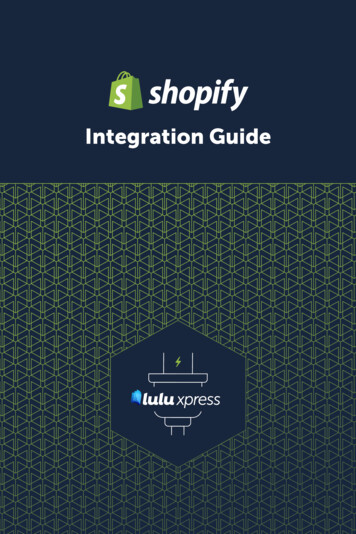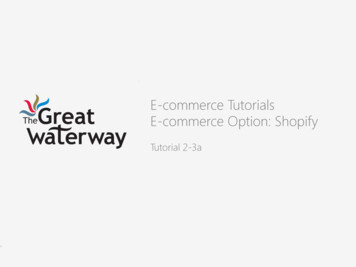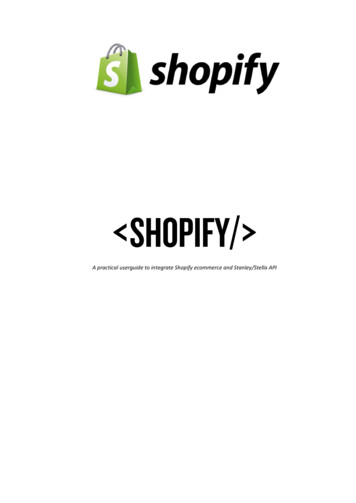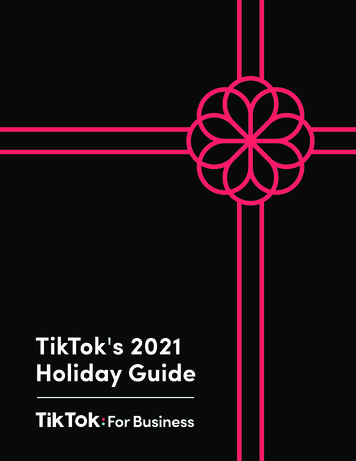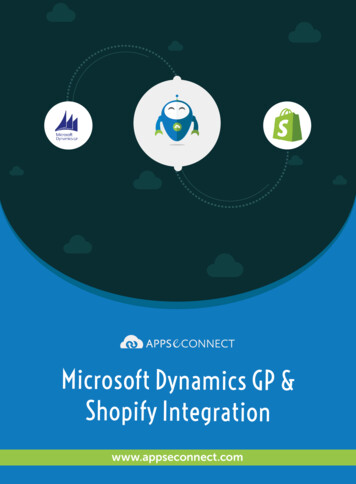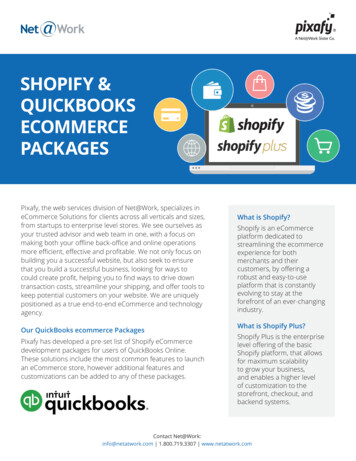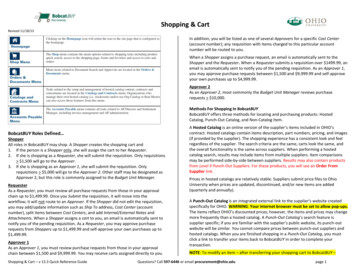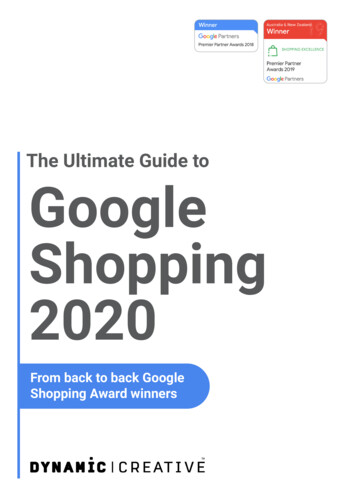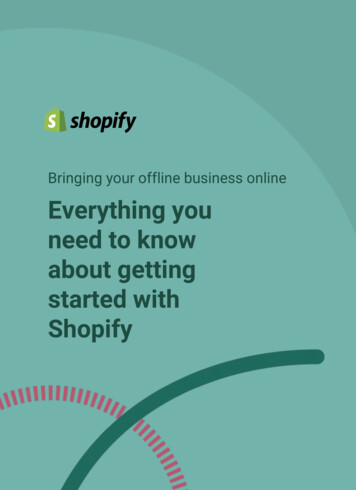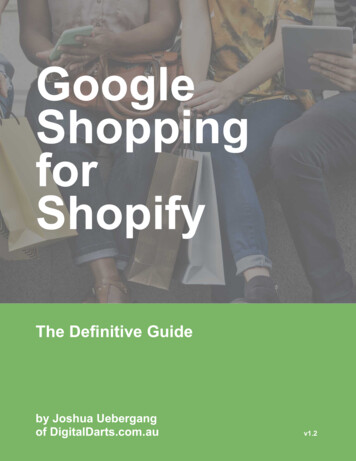
Transcription
GoogleShoppingforShopifyThe Definitive Guideby Joshua Uebergangof DigitalDarts.com.auv1.2
Table of Contents11. The Power Of Google ShoppingThe Ultimate Advertising Platform1. Measurable ROI2. Control3. Conversion Rates Of Sales And LeadsThe Downside Of Google Shopping82. How Does Google Shopping Work?Where Do Google Shopping Ads Show?Google SearchGoogle ShoppingGoogle Partner SitesGoogle DisplayYouTube143. How To Profit From Google ShoppingGoalsBuying IntentCompetitor ResearchGoogle SearchAd Preview And Diagnosis Tool21 4. How To Setup Key Google Products For AdGrowthThe Four Horsemen Of Google ShoppingSetting Up The Accounts1. Google Ads2. Google Merchant CenterBusiness Information3. Google Search Console4. Google Analytics335. Your Google Shopping Feed In ShopifyWhy Should I Optimise My Feed?What Makes A Bad Feed?Out Of StockProduct DisapprovalsInaccurate Pricing
Irrelevant SearchesUnoptimised TitlesThree Of The Best Ways To Keep Your Shopify ShoppingFeed Healthy1. Manual Input With Google Sheets2. Shopify’s Google Smart Shopping3. DataFeedWatchThe Most Important Attributes For A Google ShoppingFeedIDTitleDescriptionLinkImage LinkAvailabilityPriceGoogle Product CategoryBrandIdentifier ExistsGTINMPNColorShippingTaxOptional But Powerful Attributes For Google ShoppingProduct TypeCost Of Goods SoldSale PricePromotion IDAdditional Image LinkOther AttributesFeed SubmissionSubmit The Feed To Merchant CenterHow To Correct Google Shopping ErrorsGet The Google Shopping For Shopify InfographicDownload ItEmbed It66 6. Campaign Structure
The First Campaign—Right The First TimeGeneral SettingsBid SettingsTargeting And Scheduling SettingsStrategy And StructureCommon SegmentsCategory And Product TypeThe King And Peasant Strategy: An Overview OfPriorities And Negative Keywords797. Optimise Your Google Shopping CampaignsThe Two Levers Of Growing Ad Revenue With GoogleShoppingQuality ScoreBidsThe AIDA Model For Shopping Ads To Spot GrowthOpportunitiesGet More People In Front Of The Ad—Increasing ImpressionsGet More People Clicking On The Ad—Increasing ClicksGet More People To Buy And Buy More—Increasing Sales AndAverage Order ValueBidding Optimisation“The Sweet Spot”Considering Automated Bid StrategiesPromotional PeriodsSeasonal BidsSKU-Level BiddingBid Modifiers To Get The Right Person At The Right TimeRevisiting Campaign Structure With The King AndPeasant StrategyNegative KeywordsThe King And Peasant Strategy: How To Structure YourCampaign For Your Most Important SearchesSearch Term OptimisationToolsSniff Out The CompetitionCampaign ManagementScripts
114 8. Google Shopping Merchant Center ProgramsThe Six Types Of Google Shopping Programs1. Seller Ratings2. Product Ratings3. Dynamic Remarketing4. Merchant Promotions5. Google Shopping Actions6. Local Inventory AdsInfographic: Google Shopping Merchant CenterPrograms For ShopifyDownload ItEmbed It136 9. Expanding Beyond Google ShoppingFour Channels To Expand Beyond Google Shopping1. Video Ads2. Google Search Ads3. Google Display Ads4. Microsoft AdvertisingConclusionWhere to Next?About the Author
Before you continue:Step 1:Know of someone who runs an online store that would be happy to turnmore visitors into customers? Feel free to share with them the followinglink so they can download the latest version of this free ngStep 2:Learn the ecommerce growth secrets of “little” online stores owning theirniche to hit 1,000,000 in sales a year and beyond. Free 7-part coursemade for Shopify store owners wanting more sales.Free sign-up available now:
1. The Power Of Google ShoppingWhy The Advertising Platform CanMake A Store Succeed Overnight“Nobody reads ads. People read what interests them, andsometimes it’s an ad.”Howard Gossage, an advertising innovator known as “The Socrates of San Francisco” inthe 50s and 60sGoogle Shopping drives 76.4% of retail search ad spend in the US and 82% ofretail search ad spend in the UK, according to Search Engine Watch. It is nosurprise ad spend rises as companies report greater success on Google Shoppingover any other channel. The ad platform allows control and near-instant reportingthat surpass traditional media.Since 2002, Google has provided retailers a solution to boost sales by promotingonline inventory and increasing foot-traffic to retail stores. Previously referred to as“Google Product Search” and “Froogle,” we now know this as Google Shopping and toa lesser extent, Product Listing Ads (PLAs). Google Shopping is one type of ad on theGoogle Ads platform, formerly known as Google AdWords.From small retail startups, to major players like Amazon, businesses in theecommerce industry take to Google Shopping to drive product sales. Google in their2018 Economic Impact Report shares that "we conservatively estimate that for every 1 a business spends on Google Ads, they receive 8 in profit through Google Searchand Ads." The Google Ads model creates 70.9% of Google’s total profit. According toSummit, Google saw spend on shopping ads skyrocket by 34% in 2017—a vast jumpcompared to the 2% increase for text ads. The advertising platform is growing asretailers find profit through it.That is lovely knowing others benefit, but what do individual companies experience?1. The Power Of Google Shopping1
I run Digital Darts, a company certified by Shopify in marketing as part of theirExperts program and part of Google’s Partner program. Every day we manage adcampaigns of Shopify stores. What are real-life results we see managing Google Adsfor retailers?We have a fashion client who averages 13 for every 1 spent. There’s a companythat successfully raised money on Kickstarter to launch their pet product. They werelost at how to grow after the crowdfunded campaign. Thanks to ad campaigns thatwere well-built and managed, we were able to achieve a return on ad spend thatsmashed their goals by 4 times. A large drop-shipping company had stalled at 80kin sales for 2 years. The month we took over their Google Ads, they broke through 6figures of revenue to reach a record month.Shopping campaigns are used by stores and traders for good reason. Here are someimportant research statistics to take note of: 55% of online millennials turn to search engines when shopping. 64% of smartphone users use mobile search before visiting in store to figureout what to buy—most of them are same-day searches. 71% of smartphone users who search in store trust what they get from theirsearch more than a sales assistant.The ease, simplicity, and convenience of the online shopping model (asdemonstrated by the growth of Amazon and eBay in recent years), makes GoogleShopping campaigns a key tool in your arsenal for achieving greater sales.The Ultimate Advertising PlatformShopping ads typically appear at the top or right of search results. Other locationswhere shopping ads are used include the shopping tab of search results, YouTube,partner websites, and more. You will learn further about these various locations andhow you can use them to grow your store.1. The Power Of Google Shopping2
Billions of dollars have been put into Google’s algorithms to deliver users relevantsearch and advertising results. Google wants advertisers to maintain this experienceso its users continue to spend time on Google’s platforms. The giant givesadvertisers the tools to make scientifically accurate decisions and then rewardsthem for relevancy in the form of lower costs and increased volume.The data and trends show many businesses focus on Google Shopping as part oftheir overarching marketing plan. I love the platform for geeky reasons. Personally, Ifeel it is the ultimate advertising platform because the return on investment is clear,the control is hyper-granular, and it is a reliable lead-generation tool. We have manybusinesses thank us for doubling their total sales by using the platform.1. Measurable ROIMarketing is seen as a necessary evil. How many times have you heard the phrase,“You need to spend money to make money?” Probably more times than you’d like. Atypical store owner has to ask themselves many difficult questions such as, “Howmuch do I need to invest in marketing?” and “How do I know it’s working for me?”1. The Power Of Google Shopping3
This is where the age of digital marketing—particularly PPC (pay-per-click)—hasbeen advantageous with its ability to measure bottom-line results.Google Shopping is a prime example of a platform that allows any advertiser tobreak down real results and attribute them in a granular fashion, allowing a storeowner to see exactly how every penny was spent and what results it returned. Onceyour desired ROI is achieved, then you can increase your initial budget.The granularity goes far deeper than seeing an overall ROI. You can break it down toincredible actionable insights including: Time of day: Do you want to pay more for people when the majority ofsearches and transactions take place? Do you know what time people browseand research, but do not buy? All is possible thanks to the level of dataprovided by Google Shopping and Analytics. Device: Do people buy from you more often on mobile because it is quick andconvenient? Or do they convert later while searching on their desktopcomputer when they have more time to think about the item? I’ve turnedunprofitable campaigns into cash-cows by simply observing how mobile usersconvert at half the rate of desktop users. Seeing how bids were 50% less formobile led to a reduction of wasted ad spend and more aggressive spendingon what is profitable. Keywords: Know what specific terms people search to find your products. Theadvent of Google Analytics reporting the majority of organic keywords as(direct) / (none) meant it is difficult to know what organic keywords lead torevenue. This makes a goldmine of knowing what keywords in a paid searchcampaign lead to a sale. You can use the data to make accurate businessdecisions for search engine optimisation and product naming that wouldotherwise be a trial-and-error scenario.You can work on leveraging this data to your advantage with the second big benefitof the platform.2. ControlInsight is pointless without the ability to act on it. Google gives advertisers thecontrol of how much they want to pay for a click depending on the time of the day,1. The Power Of Google Shopping4
and the user’s device, location, and past interactions with the website.Advertisers can block ads from showing up for certain keywords. Alternatively, myrecommended option is, if you don’t want to go as far as switching off certainattributing factors, you can chose to spend more or less on them. For example, if youhave a brick-and-mortar store closed on Sunday, you could spend 50% less on thatday.Let’s look more in-depth at an example. Say you own a women’s clothing store andyour target market is women aged 25-50. When looking at the demographic data,you realise that women often click on your shopping ads and browse, but men clickless and turn into a sale (convert) more often than women. Male shoppers get you ahigher ROI. They just do. In this case, you should pay a higher cost per click to showyour ads more often to male than female users.If someone visited your website before and conducts another Google Search thattriggers your ad, most businesses will want to pay more for the user’s click becausethey are more likely to convert. You can take this one step further. Someone who hasviewed 10 pages on your store is more likely to buy than someone who has spentless than 60 seconds. You can create audiences off any type of data in your GoogleAnalytics to pay more or less for a click.This takes us close to the adage of performance-based advertising:Get the right message to the right people at the right time.3. Conversion Rates Of Sales And LeadsOther channels like display, social, or media-buys, generally speaking, see a highernumber of bounces when people reach your store. Yet the user experience on thewebsite is exactly the same compared to more targeted channels like email, organicsearch, and or Google Shopping ads.The reason for the difference is intent. User intent is the most influential factor ofconversion rate optimisation. By the very nature of search, people seek solutions totheir problems. Some searches contain more commercial intent than others. A searchfor “buy lightest camping tent” is done by someone ready to handover money. You betwith over 70% of revenue coming from ads, Google invest a lot of money into their1. The Power Of Google Shopping5
advertising technology. They want to understand when shopping ads should show soadvertisers make profit and continue to spend.Thanks to the information provided in a shopping ad of price, imagery, and a producttitle, people can make an informed decision before clicking an ad. They already knowthe price, what it looks like, and if it is potentially what they want before you pay fortheir click.Naturally having an extra marketing platform will increase the exposure of your siteand products. However, many retailers in an industry where people search for theirproducts, will tell you they see more revenue and a higher return on ad spend(ROAS)—second only to email.The Downside Of Google ShoppingThe power of Google Shopping comes with challenges. As more ecommercebusinesses take to the platform, competition can be fierce. Sellers know it as anessential element to their marketing plans. In order to remain competitive, thispushes the cost per click up and companies must increase budgets to compensate.When a new store advertises in position one, everyone else drops one position whileexperiencing a decline in sales.If you are a store owner and decide to run the campaigns yourself, you are upagainst professionals like myself that do Google Ads full-time. I regularly help shopowners in Shopify forums who wonder why they have spent 500 on ads and stillhave not made a single sale. The control of the platform brings with it a complexitythat is overwhelming for an amateur advertiser. Meanwhile, the platform is atreasure chest of opportunities for the savvy advertiser who makes full use of itsfeatures to eliminate wasted ad spend and pay aggressively for profitable users.When a business sees results from Google Ads, they invest more to expand itssuccess. This includes bringing experts in-house, buying new tools, allowing more adbudget, redesigning web pages to boost conversion rates, and improving the lifetimevalue of the customer so the company can pay more than before for a click. The aimis never about dominating the search engine. Google Shopping comes down to whocan make the most revenue per click.There is an abundance of best practices you can follow to maximise your reach and1. The Power Of Google Shopping6
return from Google Shopping. You can be a more savvy advertiser. Not only will Ibreak down how it all works, but I’ll share with you my arsenal of optimisation tipsthat allow us at Digital Darts to repeatedly grow Shopify store after Shopify store.1. The Power Of Google Shopping7
2. How Does Google Shopping Work?And Lesser Known Ways TheChannel Can Help Store Growth“The Google model of targeted advertising is appealingbecause it claims to cut down on waste. We need to ask howthat efficiency can be brought to [the] creative process.”Jerry Della Femina, a 1960s ad executive who inspired Mad Men, refers to Google andtargeted advertising in 2013 as the second golden age of advertisingGoogle Shopping begins in the Google Merchant Center where product data issent. The Merchant Center is linked to a Google Ads account where campaigns,bids, and other account-level optimisations are made.Shopping ads are different to Google search ads. For search ads, you add keywords2. How Does Google Shopping Work?8
that you want to target. A shopping ad will show if the product feed is relevant tosomeone’s search and the bid is high enough for a click.Let’s look at the most common places where shopping ads appear so you canvisualize what we’re working on. Your shopping ads can show in more places than aGoogle search result.Where Do Google Shopping AdsShow?You would have seen shopping ads at some point providing you’re in a countryeligible for shopping ads. They appear in the following places:Google SearchThis is what most people know as Google Shopping ads. These appear next to orabove search results.2. How Does Google Shopping Work?9
Google ShoppingPeople go to the primary area of Google Shopping when they click the “Shopping”link from their search results.Google Partner SitesThe full list of Google Partner websites are not disclosed. Some include Google’sown image search, internal search results of websites powered by the Google searchengine, and Gmail.2. How Does Google Shopping Work?10
Google DisplayGoogle Shopping ads on the display network most often show through remarketingads. In more recent tests, Google has shown such ads through Partner sites when awebsite has advertising space accessible to Google through the Adsense network.Below you can see remarketing ads of Google Shopping products by advertiserKogan.2. How Does Google Shopping Work?11
YouTubeGoogle Shopping ads can be coupled with any YouTube video on your YouTubechannel. The following screenshot has placeholder images showing where imagesfrom the product feed can appear.2. How Does Google Shopping Work?12
Success on these channels through Google Shopping comes down to aligning yourgoals with your feed, bids, and other campaign optimizations. Let’s discover how tobest do these for your store so you are ready to profit.2. How Does Google Shopping Work?13
3. How To Profit From Google ShoppingAligning Your Goals With TheMarket“Nobody counts the number of ads you run; they justremember the impression you make.”William Bernbach, 1949 founder of international advertising agency Doyle DaneBernbachWhat is success for you on Google Shopping? Chances are it is making enough(and a little more) revenue to cover ad spend and expenses associated withfulfilling the orders. That is the most common, first goal I hear from clients. It is agood goal and the easiest goal to measure and manage.I encourage you to look beyond last-click attribution where a customer clicks on an3. How To Profit From Google Shopping14
ad then buys. Advertising success is more than that. Searches on Google vary inintent and customers have more lifetime value for your store than their firstpurchase. The existence of competitors in Google Search results indicates otherstores have a degree of success. Let’s dig into each so you are set for advertisingsuccess.GoalsHow you define success will determine how you approach your account setup andmanagement. Goals shape your ongoing activities such as setup, optimisation andwhat you report on.First of all, you need to work out your overarching goal, such as a specific return oninvestment (ROI) or revenue you expect. You can then work out what other keyperformance indicators you need to to hit your goal. Before I manage any new adaccount, we define a return on ad spend (ROAS) goal. This lets me adjust bids andmake other optimizations to control the shopping ad spend so it hits our targetreturn on investment.If the price of your products are similar, define your cost-per-acquisition (CPA). This ishow much you are willing to pay for a sale. CPA doesn’t work as well if you haveproduct prices far apart. Work out how much of your average sale is profit, and fromthere, calculate how much profit you’re prepared to sacrifice to achieve the sale. Thelower your return on ad spend, the more volume you can drive and the greater yourchance of succeeding on Google Shopping. We’ll talk more about this when we lookat optimisation and bidding.In assessing your goal, also look long-term. Would you consider spending all profiton getting a sale if it could boost your returns over time? For low-cost products, youcan afford to make no profit to gain a customer on the back-end of your marketingfunnels. This strategy of spending more at the CPA-level or dropping your profitmargins, not only acquires a customer—they can refer-a-friend, give a product review,or build another asset like video for social proof. I know it can be hard to willinglylose profit because profit is the purpose of most business.The fastest growing stores I work with invest their profits back into the business,whether it is to increase stock levels so they stop running out of product or to scale3. How To Profit From Google Shopping15
advertising platforms. The customers you acquire can buy again via email marketingover the months and years. The secret benefit in today’s digital marketing ofacquiring customers is building your Facebook Pixel data. Once you hit 5,000purchase events in Facebook and sync these customer emails into Facebook, thesocial platform has an amazing ability from the large data set to get your ad in-frontof highly interested people.The good news with Google Shopping is you don’t have to lose money beyond thefirst month if that is your choice. You are able to make profit from the beginning.Please still consider the long-term benefits of creating regular, repeat, ravingcustomers.Buying IntentWhat does someone want when they search “Sony”? They may need product supportfor headphones, stock information, or the company’s history for a trivia night. I haveno idea! Knowing the buying intent behind the searches people make on Google letsyou reach more customers at the right time.There are three levels ofintent in search as they relateto someone’s willingness tobuy:1. Awareness2. Consideration3. IntentionThe people at the top of yoursales funnel are in theawareness phase. They arerarely ready to buy until theyunderstand more about theirproblem. This usually leads to long-tail keyword searches with informational intentsuch as “why are my pores big” and “how can I reduce my pores?” The peopleconducting these searches are gathering information. They have no apparent3. How To Profit From Google Shopping16
knowledge or awareness of any pore-reduction cream.The “consideration” search shows more intent to buy. It can indicate criteria, it cancompare, and it can seek confirmation. Example searches include: “best skin productsfor pore reduction”, “(product a) versus (product b)”, and “(product a) reviews”.Finally, the “Intention” search sits at the bottom of the conversion funnel. Thesearcher knows what product they are looking for or the brand they want to buy. Forexample, “pore minimising toner”, “(website name) reduce pores”, and “buy (producta)”.Understanding the three levels helps you decide bid amounts. Most of the time youwant your shopping ads to show for consideration and intention searches. Awarenesssearches can be as profitable as lower funnel searches if you pay less for their clicks.Awareness searches are also well-suited to lead people through a search ad to ablog post or piece of content that answers their question. If your campaigns have alot of awareness and consideration searches, but few intention searches, your ROASand volume is likely to be lower than otherwise.Competitor ResearchChances are, you have a number of competitors in mind who sell the same or similarproducts. However, this list of competitors could look different to the competitors onGoogle Shopping. Your competitors on Google Shopping have shopping ads appearon searches that could bring you sales.Understanding what your competitors do on Google Shopping lets you gaugeanother force that affects the purchase-choice of prospective customers. Even if yourcampaigns and feed is set up with all the best practices, not every searcher will clickon your ad. Clicks will still go to a competitor.It’s important to monitor competitor prices, the appearance of their ads, and thekeywords they show for. What exactly are your competitors doing? Is theresomething you could do more of in your campaigns? Are they doing anythingopposite to best practice that hints your campaigns could perform better?Understanding the answers to these questions and applying the findings to yourcampaigns gives you a competitive advantage.3. How To Profit From Google Shopping17
You may find a competitor neglecting one of their product ranges. They may notpromote it as well as they could or be avoiding ads for it altogether. You may havefound there are a lot of searches for this product thanks to the keyword planner,giving you the opportunity to tap into more search volume by optimising relevantproducts.The second benefit of monitoring competitors is knowing where you stand in pricewars. Stores frequently undercut competitors to stay equal or better in the eyes ofcustomers. This is prevalent with competitors new to the market as they can valuegetting more seller ratings and testimonials than maximising profits, in the earlystage of the business. Keep an eye on competitor’s pricing as you may be ableundercut, level off your pricing with them, or at least know who is undercutting you.With that said, let’s identify your competitors. There are some additional paid toolslike SEM Rush not mentioned here, but at this stage of gauging competition for anexisting store, a deep competitor dive is excessive.Google SearchThe good ole Google search is the quickest way to get a snapshot of the market. Usethis to identify your competitors, what they are doing, and how well their productsand service compare to yours. Doing this prior to setting up Google Shopping canhelp you look at the images used, product titles, descriptions and most importantly,pricing. It’s also beneficial to look at the service provided by competitors. Can youprovide something better such as next-day delivery, personalisation, or lower prices?These can be your unique selling propositions to stand out in the market.Sometimes spotting your competition may not be as easy as searching yourkeywords in Google. If you already run ads, a Google search may bring up yourproducts and inadvertently skew your ad data. Perhaps you want to eye-downcompetition in a different country, but you get served local ads. A competitor mayfocus on targeting only mobile devices such that sitting in your office on the laptoplooking at search results causes you to miss them. To solve this, Google have auseful tool.Ad Preview And Diagnosis ToolThe Ad Preview and Diagnosis Tool is within the Google Ads interface. It is version of3. How To Profit From Google Shopping18
the Google search engine results page. Type in your products or the keywords youmay target. The tool does not skew your stats. The big advantage is you can set thelocation and device, which is great for discovering competitors and their prices inother countries.Later we’ll cover ways to optimise your campaigns based-off competitor data. Fornow, use Google Search and the Ad Preview and Diagnosis Tool to gaugecompetition. The existence of competitors is not a bad thing. It can be helpful tohave a number of companies marketing the same products you sell (as people maydiscover the products then later buy from you) as well as giving you a businessmodel to benchmark yourself against.Competitors are expected, especially when you can setup a business in one dayusing software like Shopify. If there is no competitor, this may be a red flag manyhave fallen before you short of profit.3. How To Profit From Google Shopping19
Be mindful of the time you spend analysing competitors. Look at the market on aregular basis, but keep focused on serving your customers through your company’svision. Your customers need to be the ones who ultimately shape your business; notcompetitors.To apply goals, buyer intent, and competitor research to your Google Shoppingcampaigns, you first need a Google Ads and Merchant Center account. Let’s set upthese tools you need for success. If you have a Google Ads and Merchant Centeraccount already, you’ll discover other tools as part of the setup that will help growyour existing campaigns.3. How To Profit From Google Shopping20
4. How To Setup Key Google Products For AdGrowthBe Ready To Profit From GoogleAds“Google (and Bing and Yahoo!) don’t ‘owe’ any company traffic.If a company has to spend more on advertising on Google, inaddition to investing in search-engine-optimization, that isnot a violation of any law.”Marvin Ammori, an American lawyer best known for network neutrality and Internetfreedom issuesAre you new to Google Ads? Go through all of this chapter. Are you runningcampaigns? There are still tid-bits of gold for you in this guide to make your4. How To Setup Key Google Products For Ad Growth21
current campaigns more profitable by using the full array of tools from the Googlesuite.The Four Horsemen Of GoogleShoppingGoogle has an armory of weapons to help you win the advertising war againstcompetitors.Google Shopping uses a combination of two platforms:1. Google Ads: Control most of the levers that let you optimise for results. Mostof your time is spent here to gain insights, set budgets, and change yourtargeting settings.2. Google Merchant Center: Also referred to “MC” for short, the Merchant Centeris where you upload and optimise the feed. The platform helps you shape thefeed to satisfy Google’s guidelines.To start you need a Google Ads and Merchant Center account. There are two optionalaccounts I recommend you also set up:3. Google Search Console: Previously called Google Webmaster Tools, thisinforms you of the website’s performance within the search results. GoogleSearch Console has information about how Google’s bot sees the store,backlinks, and organic search traffic. In Google Ads the tools lets you see whatkeywords the website ranks for in organic and paid search. This helps youimprove both your paid and SEO strategies.4. Google Analytics: The platform provides several new metrics within GoogleAds about user behaviour on your store. If a campaign has 0 sales and 200clicks, and
114 8. Google Shopping Merchant Center Programs The Six Types Of Google Shopping Programs 1. Seller Ratings 2. Product Ratings 3. Dynamic Remarketing 4. Merchant Promotions 5. Google Shopping Actions 6. Local Inventory Ads Infographic: Google Shopping Merchant Center Programs For Shopify Download It Embed It 136 9. Expanding Beyond Google Shopping
